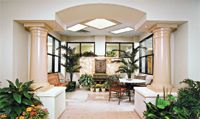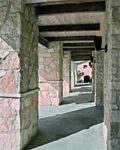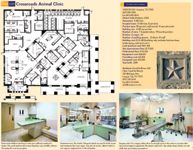Deep in the heart of Texas
A facility that includes regional architectural elements and projects warmth and southern hospitality, Crossroads Animal Clinic in Houston is an example of what you can achieve with design.
A WRAP-AROUND COVERED VERANDA, Lone Star-shaped stone detailing, heavy timber, and galvanized steel are elements of Texas regional architecture that shine bright at Crossroads Animal Clinic in Houston, a 2006 Veterinary Economics Hospital Design Competition Merit Award-winning practice. And that's just the exterior. Inside, clients find a lush atrium, spacious exam rooms, and a sick child room—a very different environment from Dr. Kelly McIntyre's previous retail-center location a half mile away.

The clinic: A metal roof and natural-colored Austin stone give the building a Texas-style look. The covered porch allows easy access to the entrance.
"I wanted to build a place where people and pets feel welcome," says Dr. McIntyre. "I didn't want a cold, sterile hospital; I wanted a warm and comforting environment." She also wanted to emphasize pets' role as part of the family. So she included larger exam rooms so that everyone in the young, growing families she finds she's catering to more often can all fit in an exam room and participate.
Catering to families
Inside the clinic, the atrium sets the mood for Dr. McIntyre's goal of a warm, family-friendly atmosphere. "The fountain trickles, there's greenery, and sunlight shines through the skylight," she says. "We also eat lunch and hold meetings or seminars in this space." And during a pet's critical surgery, clients may choose to wait in the atrium, which is a quiet, reflective spot.

Atrium: Natural light filters through the skylights in the 12-foot ceiling to accent the space. A large fountain, plants, and patio-type seating give clients a cozy place to sit.
Dr. McIntyre wanted to build the clinic not only for herself and her staff, but for her clients, too. "They've been so loyal and we really wanted them to feel involved in the whole process. I tell clients that they're part of the reason I was able to do this." And the response has been positive.
It's not unusual, she says, for a client to walk into the clinic and say, "Gosh, the reception area looks like a resort!" "I think the majority of clients were surprised when they walked in for the first time," says Dr. McIntyre. "It blew their minds. They have a concept of what a facility should look like, and ours blew them away."

Covered walkway: The view from the front door toward the west includes the stone-covered veranda. The veranda allows clients to enter and exit the facility without being exposed to the elements.
The facility has attracted new clients, too. The freestanding clinic has more visibility than the old one—partly due to a prominent cupola. "We want to put a light in it so that we're a beacon in the night. It's wired for it; we just haven't done it yet," Dr. McIntyre says.
Still, people that never knew about Dr. McIntyre's retail-center location are now stopping in. Crossroads Animal Clinic's revenue increased 30 percent to 35 percent the first year in the new facility. "If you build it, they will come," Dr. McIntyre says. "They did, and it has been great."
Of course, the team didn't forget the needs of clients' children. A playroom gives clients' kids a place to draw, read, or play with toys while their pets are visiting the clinic. And when a client wants to make a quiet exit, there's a separate side door.
Special features for the team
"Just to give you an idea, between the four doctors we have 10 young kids," Dr. McIntyre says. To help accommodate team members' parental demands, Dr. McIntyre included a sick child room, and it has been a huge hit. "Usually the children aren't so sick that they need to stay in bed. So we bring a sleeping bag, and they stay in the sick room."

Floor plan: Crossroads Animal Clinic
Dr. McIntyre loves the flexibility the room provides her team members and finds they're less likely to take time off. The room is equipped with a TV, DVD player, books, and toys that keep sick children occupied. Many windows let team members check on their children throughout the day.
This easy visibility extends throughout the practice, with interior windows that let staff members see from one end of the clinic to the other. For example, the treatment area is visible from the pharmacy and lab area.
Next on the list
Now that Dr. McIntyre and her team have settled into the new facility, she's thinking about how she can improve the clinic and provide even better service to her clients. "We have a separate boarding area for cats, but it just isn't quite what I had in mind," she says. "I want the cats to be on an outer window so they can look outside and have a bigger area for condos and a play tree. We're contemplating building a cat cottage—a strictly feline boarding facility on a half-acre lot next to the clinic that hasn't sold yet."

Lab and pharmacy: The U-shaped area features an island workstation for callbacks. The lab and pharmacy are visible from the treatment area.
The second floor of the facility also remains unfinished. Dr. McIntyre says she has also considered finishing the space, moving her office up there, and converting her former office into the cat cottage. "It's a perfect space, it has windows and it's far away from the dogs," she says.

Waiting and reception area: Four transaction workstations make it easy to interact with clients and two callback stations are hidden from public view. Twelve-foot ceilings add height and dimension to the room, and the wood elements match the exterior.
"No matter what we decide to do next, I love to pull up in front of the practice in the morning," says Dr. McIntyre. "I think, 'Wow, this place looks great.' And I couldn't have done it without my architect, my husband, and the whole team. I feel incredibly lucky."
Editors' note: For more information about hospital design, check out the Veterinary Economics Hospital Design conference, Aug. 23 to 25 in Kansas City, Mo. Topics at the conference include finding the right site and making it work, financing options, and design trends that build your business. Visit www.thecvc.com/hd for more.

Develop a project team